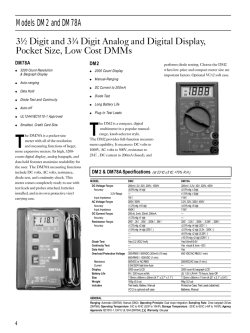
Diode Review - People - Rochester Institute of Technology
Diode Review ROCHESTER INSTITUTE OF TEHNOLOGY MICROELECTRONIC ENGINEERING Diode Review Dr. Lynn Fuller Webpage: http://people.rit.edu/lffeee Microelectronic Engineering Rochester Institute of Technology 82 Lomb Memorial Drive Rochester, NY 14623-5604 Tel (585) 475-2035 Email: [email protected] Department webpage: http://www.microe.rit.edu Rochester Institute of Technology Microelectronic Engineering 1-28-15 diode_review.ppt © January 28, 2015 Dr. Lynn Fuller, Professor Page 1 Diode Review OUTLINE Uniform Doped pn Junction Real pn Junctions Diode Temperature Sensors Photodiodes Other Semiconductors LEDs Rochester Institute of Technology Microelectronic Engineering © January 28, 2015 Dr. Lynn Fuller, Professor Page 2 Diode Review CONSTANTS Electronic charge Speed of light in vacuum Permittivity of vacuum Free electron Mass Planck constant Boltzmann constant Avogadro’s number Thermal voltage q c o mo h k Ao kT/q 1.602 E -19 Coulomb 2.998E8 m/s 8.854 E -14 F/cm 9.11E-31 Kg 6.625E-34 J s 1.38 E-23 J /°K = 8.625E-5 eV/°K 6.022E23 molecules/gm- mole @ 300 °K = 0.02586 PLAY Rochester Institute of Technology Microelectronic Engineering © January 28, 2015 Dr. Lynn Fuller, Professor Page 3 Diode Review 1 PERIODIC TABLE OF THE ELEMENTS 1.0079 2 He H 0.1787 Helium 0.0899 Hydrogen 3 6.914 4 Be 0.53 Lithium 1.85 Beryllium 1122.9898 12 Density g/cm3 24.305 Na Mg 0.97 Sodium 1.74 Magnesium 47.90 K Ca Sc Ti 0.86 Potassium 1.55 Calcium 3.0 Scandium 4.50 Titanium 38 87.62 39 88.906 40 91.22 Rb Sr Y Zr 1.53 Rubidium 2.8 Strontium 4.5 Yttrium 6.49 Zirconium 55 132.90 56 137.33 14 20.086 Si 57 138.906 58 178.49 23 50.941 24 V 51.996 Cr 7.19 5.8 Vanadium Chromium 41 92.906 Nb 42 95.94 25 54.938 180.95 183.85 27 58.9332 28 29 63.546 30 65.238 14.0067 8 15.9994 9 18.9984 10 20.179 B C N O F Ne 2.34 Boron 2.62 Carbon 1.251 Nitrogen 1.429 Oxygen 1.696 Fluorine 0.901 Neon 13 58.70 7 12.011 26.9815 14 20.086 15 30.97376 16 32.06 17 35.453 18 39.948 Al Si P S Cl Ar 2.70 Aluminum 2.33 Silicon 1.82 Phosphorous 2.07 Sulfur 3.17 Clorine 1.784 Argon 31 69.72 32 72.59 33 74.9216 34 78.96 35 79.904 36 83.80 Fe Co Ni Cu Zn Ga Ge As Se Br Kr 7.43 Manganese 7.86 Iron 8.90 Selenium 8.90 Nickel 8.96 Copper 7.14 Zinc 5.98 Gallium 5.32 Germanium 5.72 Arsenic 4.80 Selenium 3.12 Bromine 3.74 Krypton 43 Mo 60 55.847 6 10.81 Mn 98 44 61 186.207 101.07 45 102.9055 46 47 106.4 107.868 48 112.41 49 114.82 50 118.69 51 121.75 26 55.847 26 127.60 54 131.30 Ru Rh Pd Ag Cd In Sn Sb Te Fe Xe 12.2 Rhodium 12.4 Rhodium 12.0 Palladium 10.5 Silver 8.65 Cadmium 7.31 Indium 7.30 Tin 6.68 Antimony 6.24 Tellurium 7.86 Tellurium 5.89 Xenon 76 77 78 84 85 Tc 8.55 10.2 11.5 Niobium Molybdenum Technetium 59 26 5 Name 2.33 Silicon 19 39.0983 20 40.08 21 44.9559 22 85.468 Atomic Weight Symbol Atomic Number 9.01218 Li 37 4.0026 190.2 192.22 79 196.9665 80 195.09 200.59 81 204.37 82 207.2 83 206.980 209 210 86 222 Cs Ba La Hf Ta W Re Os Ir Pt Au Hg Tl Pb Bi Po At Rn 1.87 Cesium 3.5 Barium 6.7 Lanthanum 13.1 Hafnium 16.6 Tantalum 19.3 Tungstem 21.0 Rhenium 22.4 Osmium 27.16 Iridium 21.4 IPlatinum 19.3 Gold 13.53 Mercury 11.85 Thallium 11.4 Lead 9.8 Bismuth 9.4 Polonium ??? Astatine 9.91 Radon 89 104 261 105 262 106 263 87 223 88 226.02 Fr Ra ??? Francium 5 Radium 227.02 Ac PLAY Unq Unp Unh 10.07 ???? Unnilpentium ???? Actinium Unnilquadium Unnilhexium 58 140.12 59 140.91 60 Ce Pr 144.24 Nd 61 145 Pm 62 150.4 63 151.96 64 157.25 Sm 6.78 6.77 7.00 6.475 7.54 Cerium PraseoymiumNeodymium Promethium Samarium 90 232.0 Th 91 231 92 238.02 Pa U 93 237 Np 11.7 15.4 18.90 Thorium Protactinium Uranium 94 237 Eu 95 243 Pu Am 20.4 19.8 13.6 Neptunium PlutoniumAmericium Rochester Institute of Technology Microelectronic Engineering Gd 5.26 7.89 Europium Gadolinium 96 247 65 158.92 66 162.5 67 164.93 68 167.26 69 169.93 70 173.04 71 174.97 Tb Dy Ho Er Tm Yb Lu 8.27 Terbium 8.54 Dysprosium 8.90 Holmium 9.06 Erbium 9.33 Thulium 6.98 Ytterbium 9.84 Lutetium 97 247 98 251 99 252 Cm Bk Cf Es 13.511 Curium ???? Berkelium ???? Californium ???? Einsteinium © January 28, 2015 Dr. Lynn Fuller, Professor 100 257 101 Fm 258 Md ???? ???? Fermiumr Mendelevium Page 4 102 259 103 260 No Lr ???? Nobelium ???? Lawrencium Diode Review MATERIAL PROPERTIES Symbol Atoms per unit cell Atomic Number Atomic weight Lattice constant Atomic density Density Energy Gap 300°K Relative permittivity Index of refraction Melting point Specific heat Thermal diffusivity Coefficient expansion Intrinsic carrier conc Electron Mobility Hole Mobility Density of States conduction Density of States valance Breakdown Electric Field Effective mass electron Effective mass hole Electron affinity Z MW ao No d Eg r n Tm Cp K Dth ni µn µp Nc Nv E mn*/mo mp*/mo qX Units g/g-mole nm cm-3 g cm-3 eV °C J (gK)-1 w(cmK)-1 K-1 cm-3 cm2/Vs cm2/Vs cm-3 cm-3 V/cm eV Si 8 14 28.09 0.54307 5.00E22 2.328 1.124 11.7 3.44 1412 0.70 0.87 2.5E-6 1.45E10 1417 471 2.8E19 1.04E19 3E5 1.08 0.81 4.05 Ge 8 32 72.59 0.56575 4.42E22 5.323 0.67 16.0 3.97 937 0.32 0.36 5.7E-6 2.4E13 3900 1900 1.04E19 6.0E18 8E4 0.55 0.3 4.00 GaAs 8 31/33 144.64 0.56532 2.21E22 5.316 1.42 13.1 3.3 1237 0.35 0.44 5.9E-6 9.0E6 8800 400 4.7E17 7.0E18 3.5E5 0.068 0.5 4.07 GaP 8 31/15 100.70 0.54505 2.47E22 4.13 2.24 10.2 3.3 1467 Si3N4 14/8 60.08 14/7 140.28 0.775 1.48E22 3.44 4.7 7.5 2.0 0.004 5.3E-6 2.20E22 2.19 8~9 3.9 1.46 1700 1.4 0.32 5E-6 300 100 20 10E-8 6~9E6 0.5 0.5 4.3 Rochester Institute of Technology Microelectronic Engineering © January 28, 2015 Dr. Lynn Fuller, Professor SiO2 Page 5 1.0 0.17 2.8E-6 Diode Review UNIFORMLY DOPED PN JUNCTION P+ Phosphrous donor atom and electron Space Charge Layer P+ Ionized Immobile Phosphrous donor atom BB- Ionized Immobile Boron acceptor atom + n = ND p = NA B- + B- B- + B- p-type Boron acceptor atom and hole B- charge density, qNA W1 =qND W2 P+ P+ P+ P+ P+ P+ P+ P+ P+ +VR n-type +qND -W1 x W2 -qNA Electric Field, Potential, Rochester Institute of Technology Microelectronic Engineering © January 28, 2015 Dr. Lynn Fuller, Professor +VR Page 6 Diode Review UNIFORMLY DOPED pn JUNCTION From Physical Fundamentals: Potential Barrier - Carrier Concentration: = KT/q ln (NA ND /ni2) From Electric and Magnetic Fields : Gauss’s Law, Maxwells 1st eqn: = D Relationship between electric flux D and electric field : D = Poisson’s Equation: 2 = - / Definition of Electric Field: = - V Rochester Institute of Technology Microelectronic Engineering © January 28, 2015 Dr. Lynn Fuller, Professor Page 7 Diode Review FROM PHYSICS (FERMI STATISTICS) q(Vbi) = (Ei - Ef)p-side + (Ef-Ei) n-side p= ni e(Ei-Ef)/KT/q ln(p/ni) = ln e(Ei-Ef)/KT/q KT/q ln(p/ni) = (Ei-Ef)p-side n= ni e(Ef-Ei)/KT/q ln(n/ni) = ln e(Ef-Ei)/KT/q KT/q ln(n/ni) = (Ef-Ei)n-side = KT/q ln (NA ND /ni2) ni = 1.45E10 cm-3 for silicon Rochester Institute of Technology Where NAEngineering =~p in p-type silicon and ND=~n in n-type silicon Microelectronic © January 28, 2015 Dr. Lynn Fuller, Professor Page 8 Diode Review UNIFORMLY DOPED PN JUNCTION Built in Voltage: = KT/q ln (NA ND /ni2) ni = 1.45E10 cm-3 Width of Space Charge Layer, W: with reverse bias of VR volts W W1 W2 = [ (2 q +VR) (1/NA 1/ND)]1/2 W1 width on p-side W1 = W [ND/(NA ND)] W2 width on n-side W2 = W [NA/(NA ND)] Maximum Electric Field: = - [(2q/ +VR) (NA ND/(NA ND))]1/2 Junction Capacitance per unit area: Cj’ rW = r[(2 q +VR) (1/NA 1/ND)]1/2 Rochester Institute of Technology Microelectronic Engineering o r = 8.85E-12 (11.7) F/m = 8.85E-14 (11.7) F/cm © January 28, 2015 Dr. Lynn Fuller, Professor Page 9 Diode Review EXAMPLE Example: If the doping concentrations are Na=1E15 and Nd=3E15 cm-3 and the reverse bias voltage is 0, then find the built in voltage, width of the space charge layer, width on the n-side, width on the pside, electric field maximum and junction capacitance. Repeat for reverse bias of 10, 40, and 100 volts. = Vbi = KT/q ln (NA ND /ni2) = W W1 W2 = [ (2/q) ( +VR) (1/NA 1/ND)]1/2 = W1 = W2 = Emax = Cj = Rochester Institute of Technology Microelectronic Engineering © January 28, 2015 Dr. Lynn Fuller, Professor Page 10 Diode Review EXAMPLE CALCULATIONS Rochester Institute of Technology Microelectronic Engineering © January 28, 2015 Dr. Lynn Fuller, Professor Page 11 Diode Review REAL JUNCTION Real pn junctions: The uniformly doped abrupt junction is rarely obtained in integrated circuit devices. (epi layer growth is close). Diffused pn junction: NA NBC = ND (x) x 0 Xj Rochester Institute of Technology Microelectronic Engineering © January 28, 2015 Dr. Lynn Fuller, Professor Page 12 Diode Review REAL pn JUNCTION Given, Xj, NA (X), ND (X) Calculate potential V1 from physical fundamentals: V1= KT/q ln (NA ND /ni2) + VR Pick an X1 to the left of Xj. Calculate the total charge per unit area in the region Between X1 and Xj. This charge is Q1. Calculate potential V2 from E & M fields fundamentals: 2 Pick an X2 to the right of Xj. Calculate the total charge per unit area in the region between X2 and Xj. This charge is Q2. = - / No V1 = V2 Yes No Calculate W1 = X1, W2 = X2 W = W1 + W2, Cj, other Q1 = Q2 Rochester Institute of Technology Microelectronic Engineering Yes © January 28, 2015 Dr. Lynn Fuller, Professor Page 13 Diode Review REAL, UNIFORM DOPED, SINGLE SIDED DIODES Example: assume that the heavily doped side of a pn junction is doped at 1E20, calculate the doping necessary on the lightly doped side such that the space charge layer is ~0.1 µm. With 5 volts reverse bias. = KT/q ln (NA ND /ni2) guess ~0.9 volts W W1 W2 = [ (2/q) ( +VR) (1/NA 1/ND)]1/2 = 0.1 µm = 0.1E-4 cm 5.9V 0 N 2 11.78.85-145.91.6-190.1-42 7.617 cm-3 Rochester Institute of Technology Microelectronic Engineering © January 28, 2015 Dr. Lynn Fuller, Professor Page 14 Diode Review CURRENTS IN PN JUNCTIONS Id VRB = reverse breakdown voltage Forward Bias Is VD Reverse Bias Vbi = turn on voltage ~ 0.7 volts for Si Id Ideal diode equation p n + VD Rochester Institute of Technology Microelectronic Engineering Id = Is [EXP (q VD/KT) -1] Is = qA (Dp/(LpNd) +Dn/(LnNa))ni2 © January 28, 2015 Dr. Lynn Fuller, Professor Page 15 Diode Review INTEGRATED DIODES n+ n-well p+ p-wafer p+ means heavily doped p-type n+ means heavily doped n-type n-well is an n-region at slightly higher doping than the p-wafer Note: there are actually two pn junctions, the well-wafer pn junction should always be reverse biased Rochester Institute of Technology Microelectronic Engineering © January 28, 2015 Dr. Lynn Fuller, Professor Page 16 Diode Review REAL DIODES Series Resistance =1/4.82m=207 Junction Capacitance ~ 2 pF Is = 3.02E-9 amps BV = > 100 volts Size 80µ x 160µ P N Rochester Institute of Technology Microelectronic Engineering © January 28, 2015 Dr. Lynn Fuller, Professor Page 17 Diode Review DIODE SPICE MODEL DXXX N(anode) N(cathode) Modelname .model Modelname D Is=Value Cjo=value Rs=value Model Parameter Is reverse saturation current N emission coefficient RS series resistance VJ built-in voltage CJ0 zero bias junction capacitance M grading coefficient BV Breakdown voltage IBV Reverse current at breakdown MEMS Diode Default Value Extracted Value 1e-14 A 3.02E-9 A 1 1 0 207 ohms 1V 0.6 0 2pF 0.5 0.5 infinite 400 1E-10 A - .model RITMEMS D IS=3.02E-9 N=1 RS=207 Rochester Institute of Technology +VJ=0.6 CJ0=2e-12 M-0.5 BV=400 Microelectronic Engineering © January 28, 2015 Dr. Lynn Fuller, Professor Page 18 Diode Review DIODE TEMPERATURE DEPENDENCE Id = IS [EXP (q VD/KT) -1] Neglect the –1 in forward bias, Solve for VD VD = (KT/q) ln (Id/IS) = (KT/q) (ln(Id) – ln(Is)) eq 1 Take dVD/dT: note Id is not a function of T but Is is dVD/dT = (KT/q) (dln(Id)/dT – dln(Is)/dT) + K/q (ln(Id) – ln(Is)) zero VD/T from eq 1 Rewritten dVD/dT = VD/T - (KT/q) ((1/Is) dIs/dT ) eq 2 Now evaluate the second term, recall Is = qA (Dp/(LpNd) +Dn/(LnNa))ni2 Rochester Institute of Technology Microelectronic Engineering Note: Dn and Dp are proportional to 1/T © January 28, 2015 Dr. Lynn Fuller, Professor Page 19 Diode Review DIODE TEMPERATURE DEPENDENCE ni2(T) = A T 3 e - qEg/KT and This gives the temperature dependence of Is Is = C T 2 e - qEg/KT Now take the natural log ln Is = ln (C T 2 e - qEg/KT) Take derivative with respect to T eq 3 (1/Is) d (Is)/dT = d [ln (C T 2 e -qEg/KT)]/dT = (1/Is) d (CT2e-qEg/KT)dT = (1/Is) [CT2 e-qEg/KT(qEg/KT2) + (Ce-qEg/KT)2T] = (1/Is) [Is(qEg/KT2) + (2Is/T)] Back to eq 2 dVD/dT = VD/T - (KT/q) [(qEg/KT2) + (2/T)]) dVD/dT = VD/T - Eg/T - 2K/q) Rochester Institute of Technology Microelectronic Engineering © January 28, 2015 Dr. Lynn Fuller, Professor Page 20 Diode Review EXAMPLE: DIODE TEMPERATURE DEPENDENCE dVD/dT = VD/T - Eg/T - 2K/q Silicon with Eg ~ 1.2 eV, VD = 0.6 volts, T=300 °K dVD/dT = .6/300 – 1.2/300) - (2(1.38E-23)/1.6E-19 = -2.2 mV/° T2 I T1 T1<T2 V Rochester Institute of Technology Microelectronic Engineering © January 28, 2015 Dr. Lynn Fuller, Professor Page 21 Diode Review DIODE TEMPERATURE SENSOR RESPONSE Poly Heater, Buried pn Diode, N+ Poly to Aluminum Thermocouple P+ N+ Apply 5 volts (gives ~ 65mA) P=IV =0.3 watts Delta Vd = 0.64 -0.48 = 0.16 Delta T = 0.16 / 2.2mV = 72.7 °C Rochester Institute of Technology Microelectronic Engineering © January 28, 2015 Dr. Lynn Fuller, Professor Page 22 Diode Review PHOTODIODE space charge layer + B- P+ B- p-type B- B- B- B- - P+ + electron and hole pair - P+ + P+ P+ P+ B- + B- + B- P+ + P+ P+ P+ I BP+ B- - + n-type P+ P+ Phosphrous donor atom and electron Ionized Immobile Phosphrous donor atom Ionized Immobile Boron acceptor atom Boron acceptor atom and hole Rochester Institute of Technology Microelectronic Engineering © January 28, 2015 Dr. Lynn Fuller, Professor Page 23 Diode Review V I p I n I + V - V No Light More Light Most Light Adsorption Coefficient, a (1/cm) ADSORPTION VERSUS DISTANCE 1.00E+06 Adsorption Coefficient vs Wavelength For Silicon 1.00E+05 1.00E+04 1.00E+03 1.00E+02 1.00E+01 1.00E+00 1.00E-01 1.00E-02 1.00E-03 1.00E-04 1.00E-05 1.00E-06 250 450 650 850 1050 Wavelength (nm) Rochester Institute of Technology Microelectronic Engineering f(x) = f(0) exp-a x Find % adsorbed for Green light at x=5 µm and Red light at 5 µm © January 28, 2015 Dr. Lynn Fuller, Professor Page 24 1250 1450 Diode Review PHOTO DIODE RESPONSE TO LIGHT 1mm 2mm 42uA P N Rochester Institute of Technology Microelectronic Engineering © January 28, 2015 Dr. Lynn Fuller, Professor Page 25 Diode Review CHARGE GENERATION vs WAVELENGTH E = h = hc / h = 6.625 e-34 j/s = (6.625 e-34/1.6e-19) eV/s 2 1 E = 1.55 eV (red) E = 2.50 eV (green) E = 4.14 eV (blue) 3 + BP+ B- B- B- BP+ n-type P+ - + B- + P+ P+ + 4 p-type P+ P+ P+ B- P+ II B- B- - + P+ P+ Rochester Institute of Technology Microelectronic Engineering © January 28, 2015 Dr. Lynn Fuller, Professor Page 26 Diode Review VARIOUS SEMICONDUCTORS E = h = hc / What wavelengths will not generate e-h pairs in silicon. Thus silicon is transparent or light of this wavelength or longer is not adsorbed? h = Plank’s constant c = speed of light From: Micromachined Transducers, Gregory T.A. Kovacs Rochester Institute of Technology Microelectronic Engineering Material Bandgap eV @ 300°K max (um) GaN 3.360 0.369 ZnO 3.350 0.370 SiC 2.996 0.414 CdS 2.420 0.512 GaP 2.260 0.549 CdSe 1.700 0.729 GaAs 1.420 0.873 InP 1.350 0.919 Si 1.120 1.107 Ge 0.660 1.879 PbS 0.410 3.024 PbTe 0.310 4.000 InSb 0.170 7.294 © January 28, 2015 Dr. Lynn Fuller, Professor Page 27 Diode Review LIGHT EMITTING DIODES (LEDs) Electron concentration vs distance Hole concentration vs distnace Light Light Space charge Layer x x P-side N-side In the forward biased diode current flows and as holes recombine on the n-side or electrons recombine on the p-side, energy is given off as light, with wavelength appropriate for the energy gap for that material. = h c / E h = Plank’s constant Rochester Institute of Technology c = speed of light Microelectronic Engineering © January 28, 2015 Dr. Lynn Fuller, Professor Page 28 Diode Review LED Light Emitting Diode -LED Flat n p - Va + Rochester Institute of Technology Microelectronic Engineering © January 28, 2015 Dr. Lynn Fuller, Professor Page 29 Diode Review OPTICAL LINK CIRCUIT DESIGN Lets design a LED/Photo Detector circuit for a digital communication link. Assumptions: Block Diagram: Circuit Diagram: Rochester Institute of Technology Microelectronic Engineering © January 28, 2015 Dr. Lynn Fuller, Professor Page 30 Diode Review REFERENCES 1. Micromachined Transducers, Gregory T.A. Kovacs, McGrawHill, 1998. 2. Chapter 3 of Microelectronic Circuits, by Sedra and Smith 3. http://www.digikey.com Rochester Institute of Technology Microelectronic Engineering © January 28, 2015 Dr. Lynn Fuller, Professor Page 31 Diode Review HOMEWORK: DIODE REVIEW 1. Look up the 1N4448 diode on the Digikey.com webpage, find the unit price, max current, max reverse voltage, package types, etc. 2. A pn junction has Na=2e16 and Nd=5e17. At 0 volts bias calculate the Vbi, W, W1, W2, Emax, and Cj. 3. Calculate the reverse breakdown voltage for a pn junction with Nd=1e19 and Na=2.75e16. 4. Design a pn junction and an amplifier circuit that will make a good photo detector for red light. State reasonable assumptions. 5. A diode is used to rectify an ac voltage from a transformer and charge a 1uF capacitor. Estimate how long it will take the capacitor to discharge from 3 volts to 1.5 volts (once ac voltage is turned off) Rochester Institute of Technology a) with no load b) with a scope probe across the capacitor. Microelectronic Engineering © January 28, 2015 Dr. Lynn Fuller, Professor Page 32 Diode Review HOMEWORK: DIODE REVIEW 6. Repeat problem 5 but use the largest value 3 volt super capacitor available from digikey.com. 7. Diodes and capacitors can be used to create a very large dc voltage from a relatively small ac voltage. These circuits are called voltage multipliers. Using a 5 volt peak ac voltage estimate the dc output voltage of this multiplier circuit. Vin Vout Rochester Institute of Technology Microelectronic Engineering © January 28, 2015 Dr. Lynn Fuller, Professor Page 33 Diode Review OPTICAL LINK CIRCUIT DESIGN Design a LED/Photo Detector circuit for a digital communication link. Assumptions: Assume we have +5 and -5 volts available and the digital signal is 0 or 5 volts. Block Diagram: Digital In LED …. Photo Detector I to V Amp Analog V To Digital Circuit Design: Rochester Institute of Technology Microelectronic Engineering © January 28, 2015 Dr. Lynn Fuller, Professor Page 34 Digital Out
© Copyright 2026



